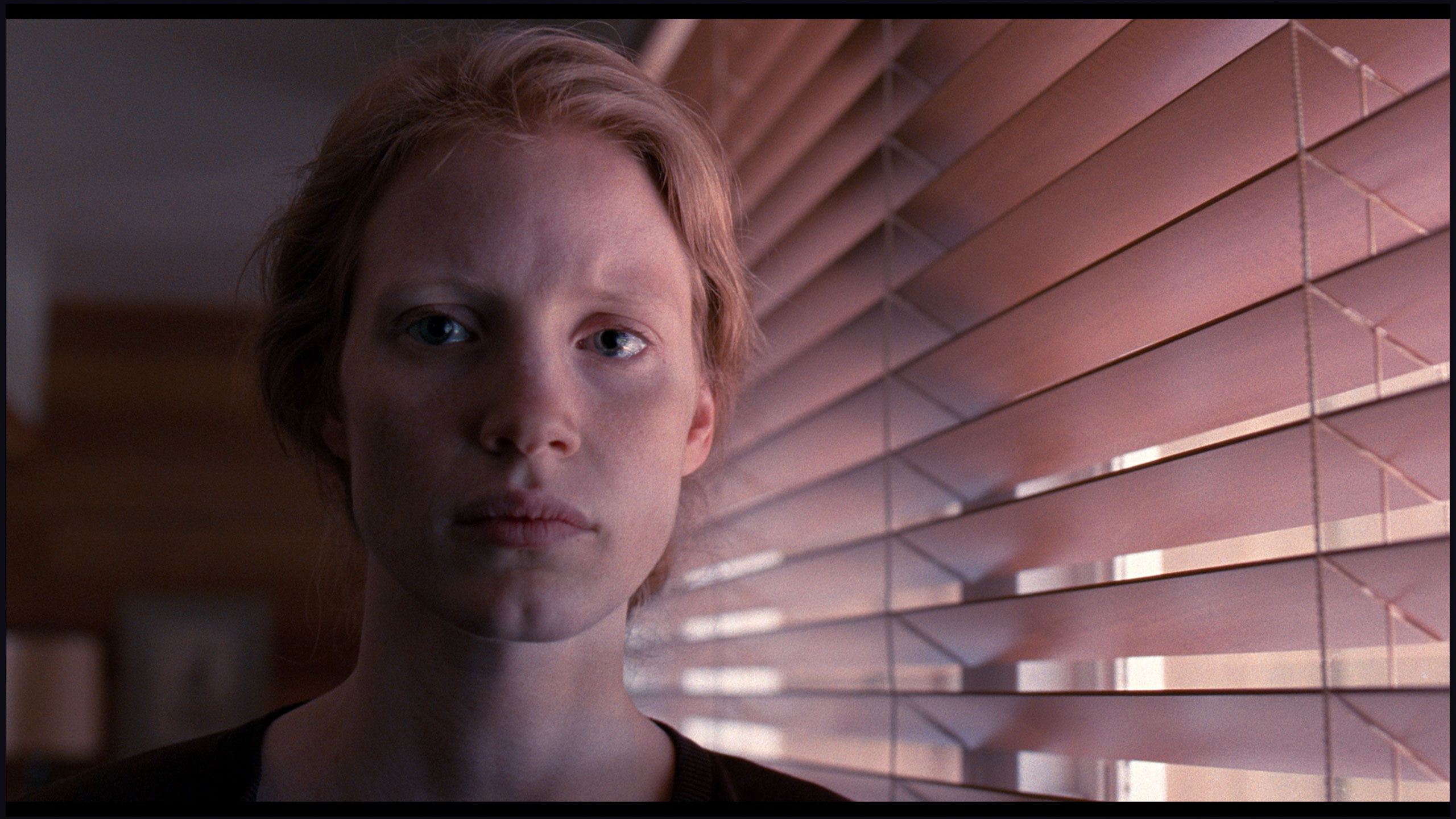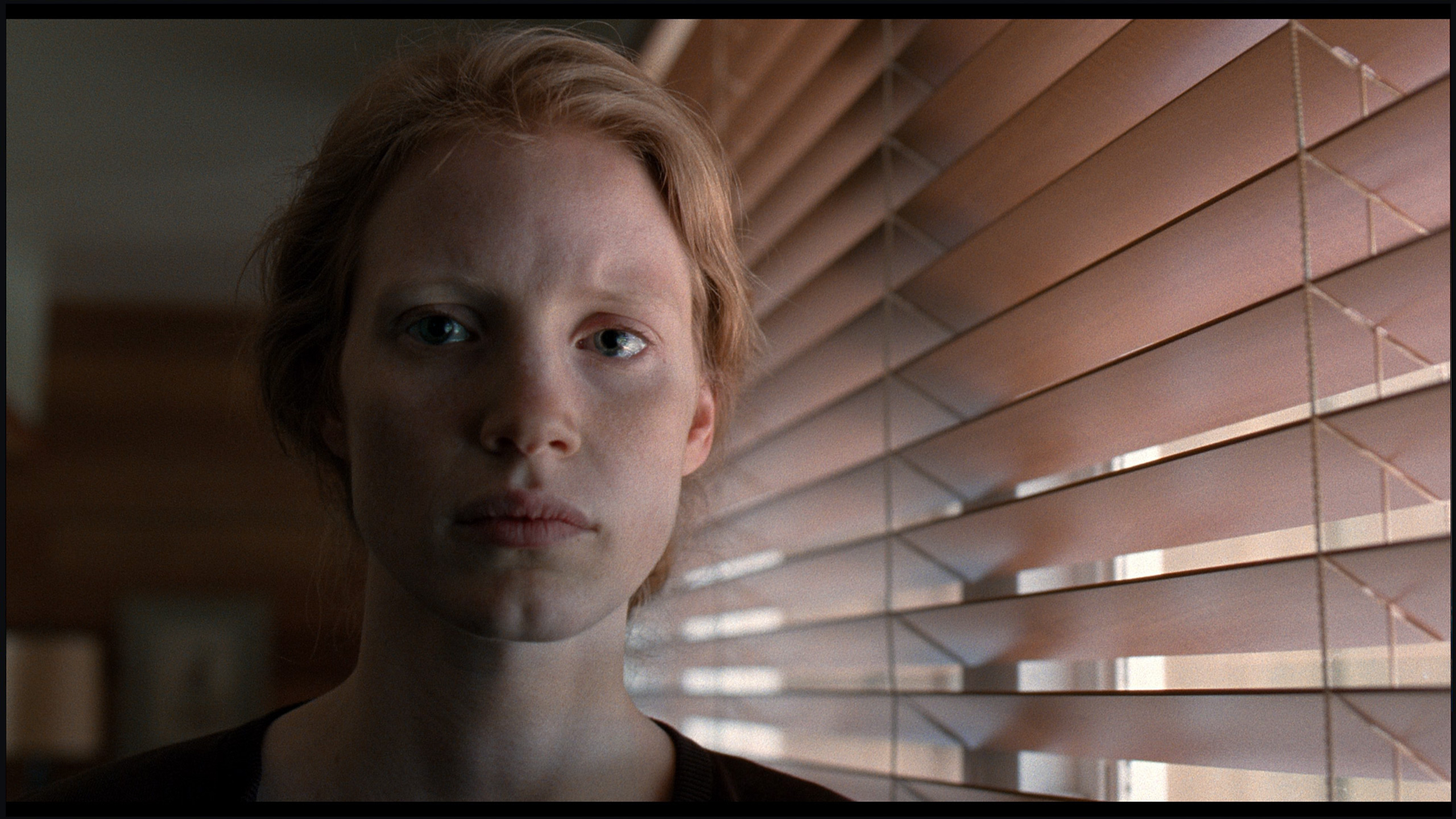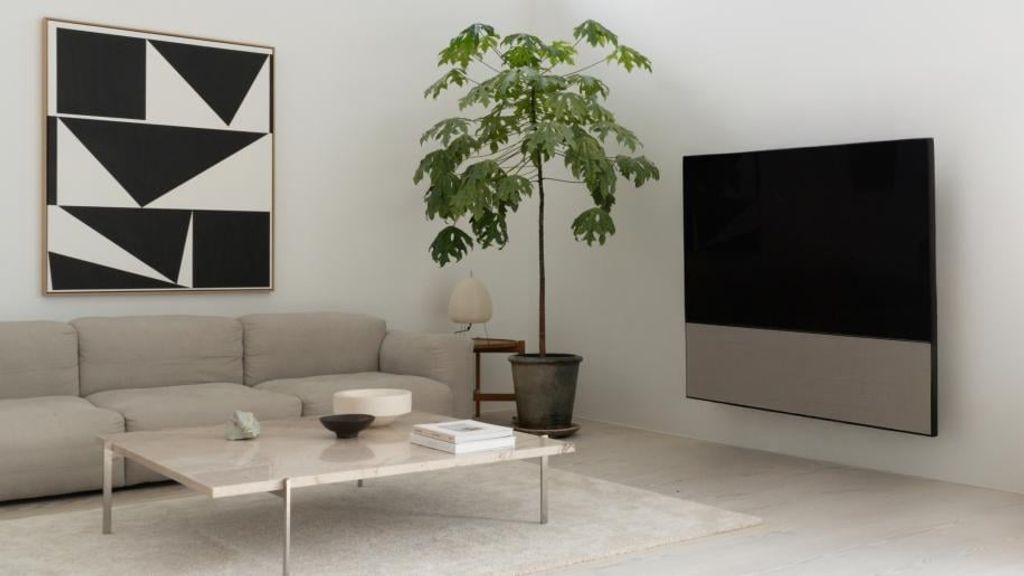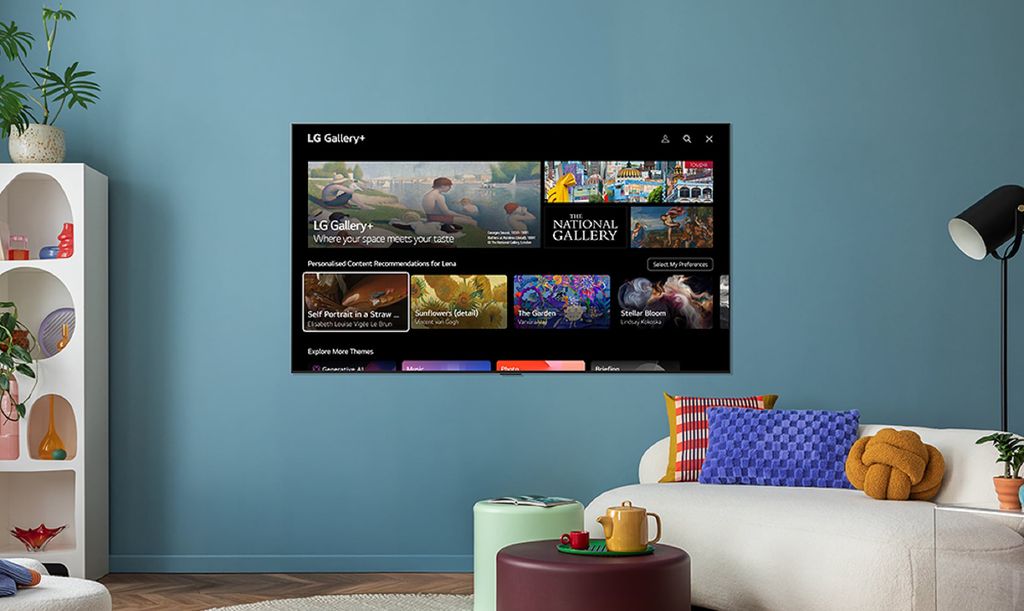- Matching (Score)
- Our verdict
- Competing TVs
- TV appearance
- Where to buy
- Contrast and black detail
- HDR effect quality
- Factory color reproduction
- Color reproduction after calibration
- Smoothness of tonal transitions
- Image scaling and smoothness of tonal transitions
- Blur and motion smoothness
- Console compatibility and gaming features
- Input lag
- Compatibility with PC
- Viewing angles
- TV efficiency during daytime
- TV features
- Apps
- Playing files from USB
- Sound
- Details about the matrix
Samsung The Frame 2025 (LS03F) Review
The Frame / LS03FAU
Available screen sizes:

Complete the survey to find out the result
Panel type: LCD VA Refresh rate: 144Hz Brand: SAMSUNG Resolution: 3840x2160 System: Tizen Model year: 2025
Samsung The Frame is a television that many people associate more with a wall frame and displaying artwork than with traditional TV watching. In the 2025 version, the manufacturer promises not only great design but also better picture quality and modern Smart features. We checked whether this elegant appearance truly hides a good television. Welcome to the review of the latest Samsung The Frame 2025 LS03F!
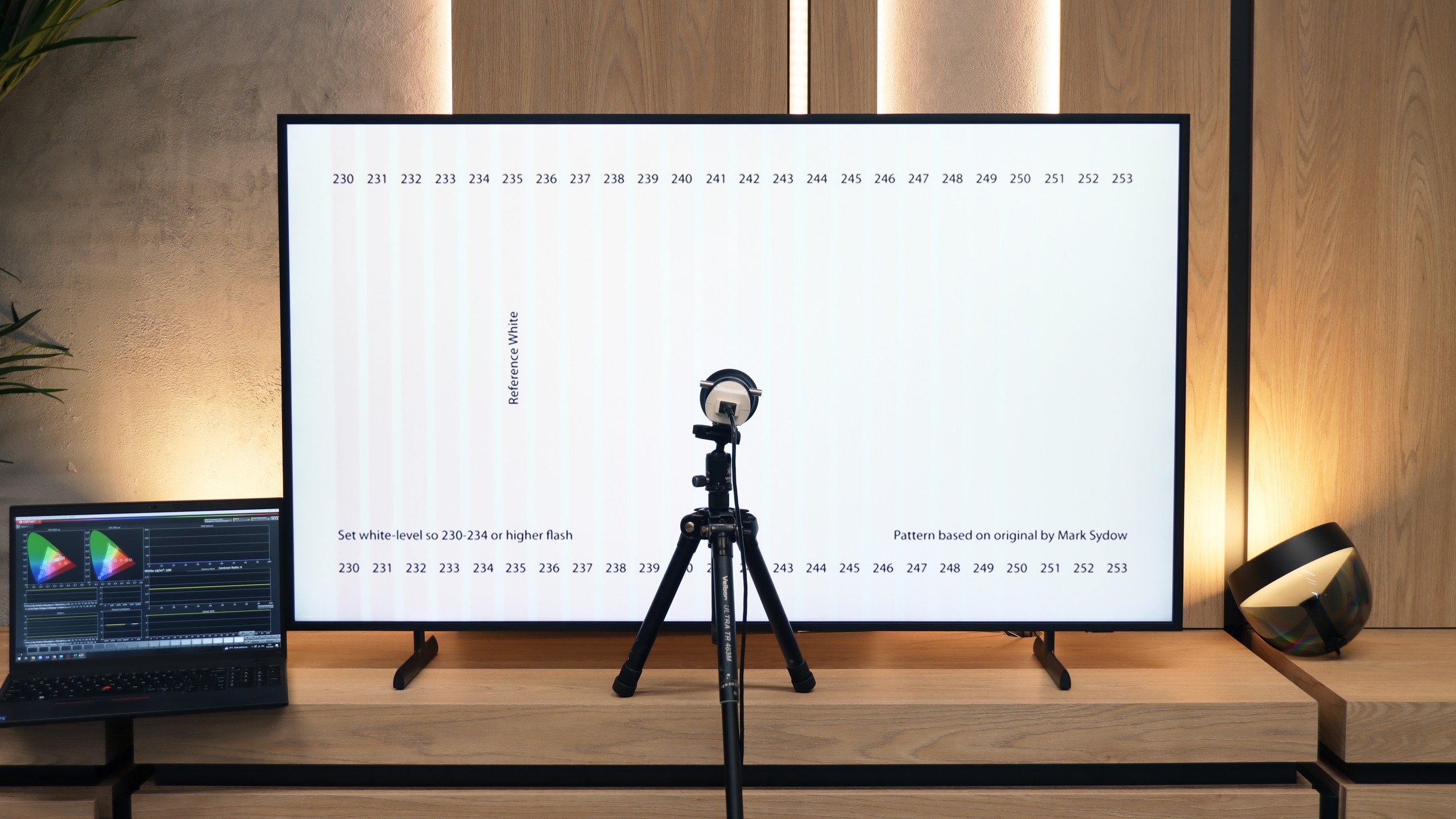
SAMSUNG LS03F - Our verdict
7.0
Overall rating
Samsung The Frame 2025 is a TV unlike any other – and even though competition has emerged for it, it still does it best. The matte display, flush mounting to the wall, and one thin cable thanks to the One Connect module make the device look more like a painting than any other screen. The Art Store app still offers the best scanned artwork on the market (even if it's subscription-based), and with interchangeable frames, we can adapt the TV to the interior almost like a piece of furniture. As for the image itself, because we are also talking about a regular TV, there are no significant changes, but also no disappointments compared to last year's model LS03D. The Frame still offers high native contrast and solid brightness at 600 nits, which combined with the matte coating provides very comfortable use during the day. The colors are not as vibrant as on glossy screens, but against the backdrop of competing matte constructions – it performs the best. A novelty is the 144 Hz refresh rate, though in practice, mainly PC gamers will benefit from it. And indeed – in terms of features for gamers, The Frame has almost everything: low input lag, variable refresh rate (VRR) support, automatic game mode (ALLM), Game Bar, and a unique motion smoother designed for gaming. Unfortunately, not everything is as perfect as it might seem. Why? Because the HGiG mode is suddenly missing from the latest version of the Tizen system. And here Samsung really should respond, as for many gamers this is a crucial element of screen selection. And we fully understand that. Although LS03F The Frame 2025 doesn’t bring major revolutions, it is still a unique TV that, apart from its appearance, offers quite a solid picture and extensive gaming features. It’s just a shame that year after year we also encounter new compromises.
Advantages
The matte display effectively reduces reflections
Customization options for the screen with interchangeable frames + art mode
Free accessories in the form of a wall mount + OneConnect module
High native contrast
Decent brightness
High refresh rate - 120/144Hz
Lots of features for gamers - VRR, ALLM, Gamebar, proprietary motion smoother working in games
Disadvantages
No HGiG mode – makes it difficult to set HDR accurately on the console.
No DTS support – requires additional equipment for certain films from Blu-ray discs.
Paid image mode
Movies and series in UHD quality
6.8
Classic TV, YouTube
6.5
Sports broadcasts (TV and apps)
6.4
Gaming on console
8.4
TV as a computer monitor
8.2
Watching in bright light
6.3
Utility functions
7.2
Apps
8.7
Sound quality
6.0
Complete the survey to find out what fits your preferences
SAMSUNG LS03F - Competing TVs in this price range
SAMSUNG LS03F - TV appearance
HDMI inputs: 3 x HDMI 2.0, 1 x HDMI 2.1 (40Gbps) Outputs: Toslink (Optical audio), eARC (HDMI), ARC (HDMI) Network Interfaces: Wi-Fi 2.4GHz, Wi-Fi 5GHz
Build quality: Premium
Stand type: Legs
Bezel colour: Changeable Frame
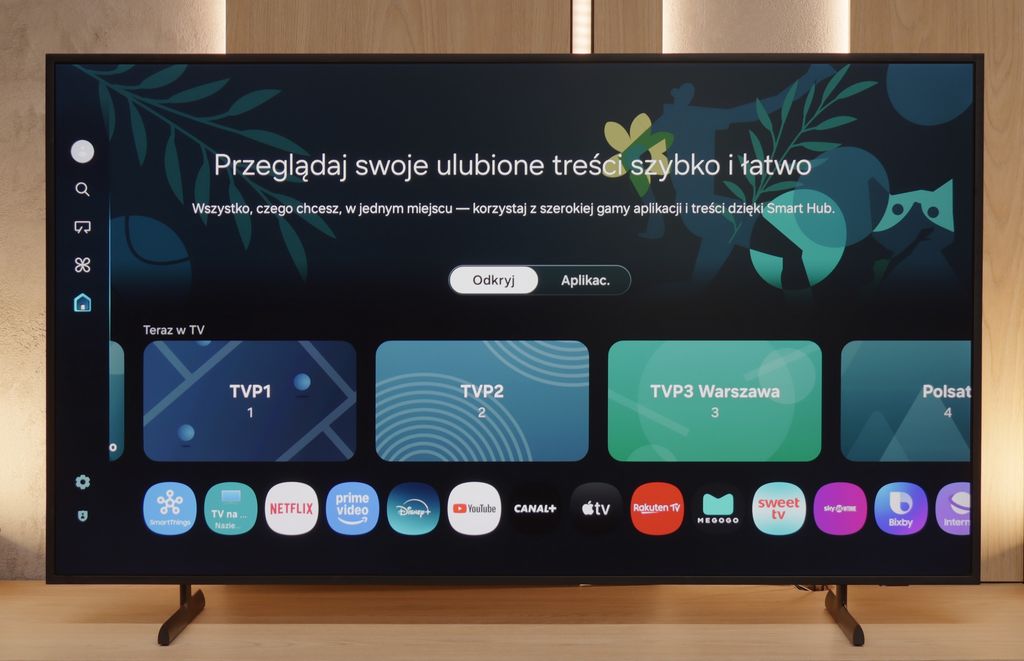


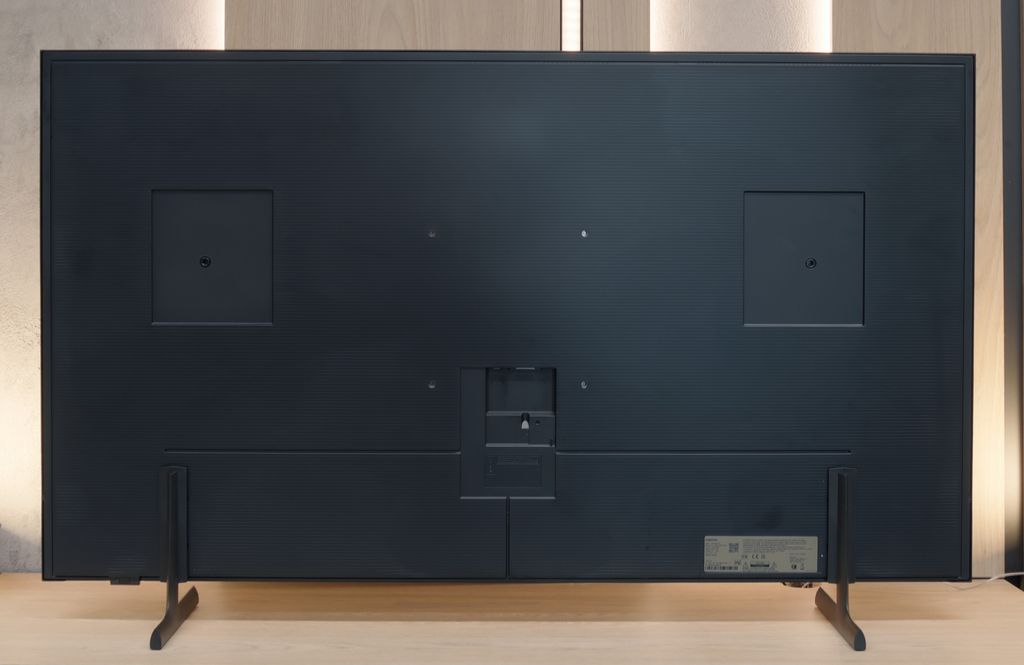
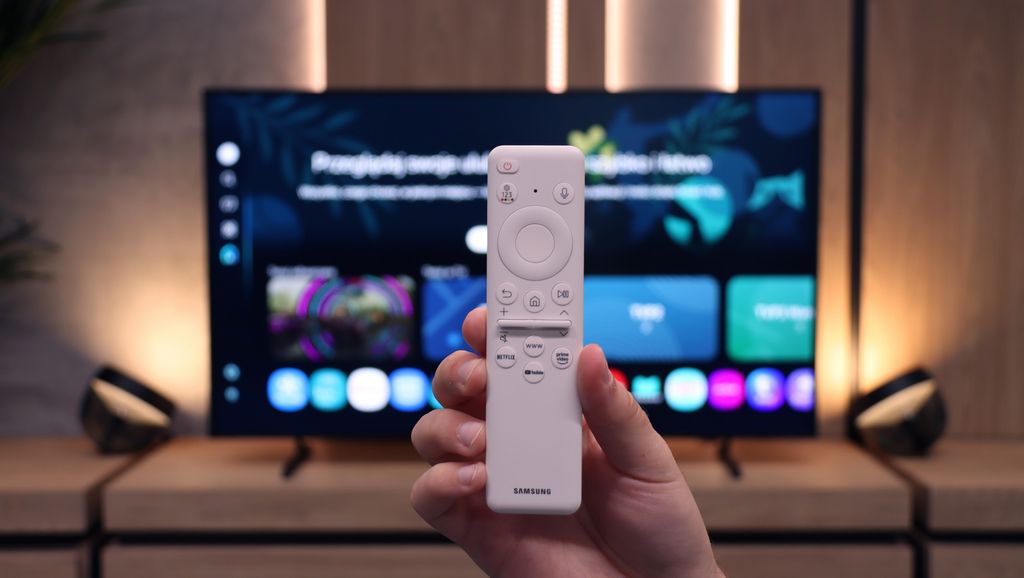
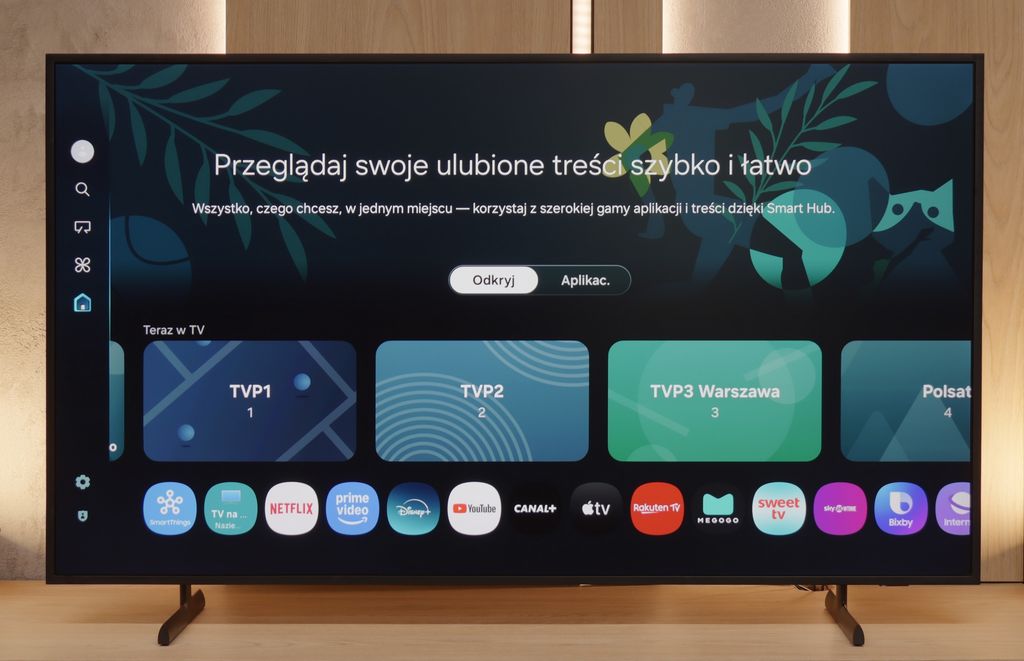
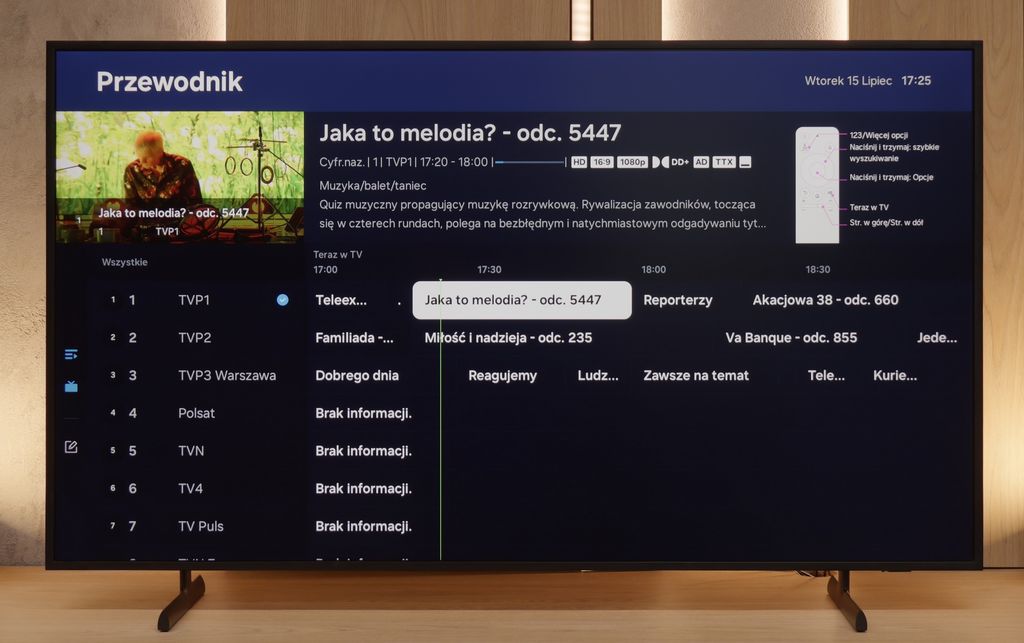
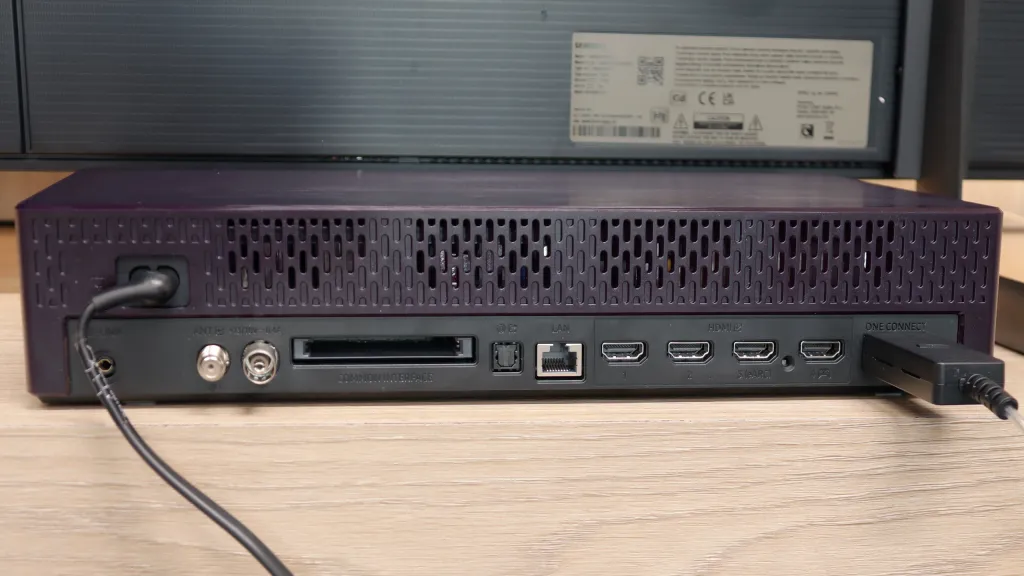
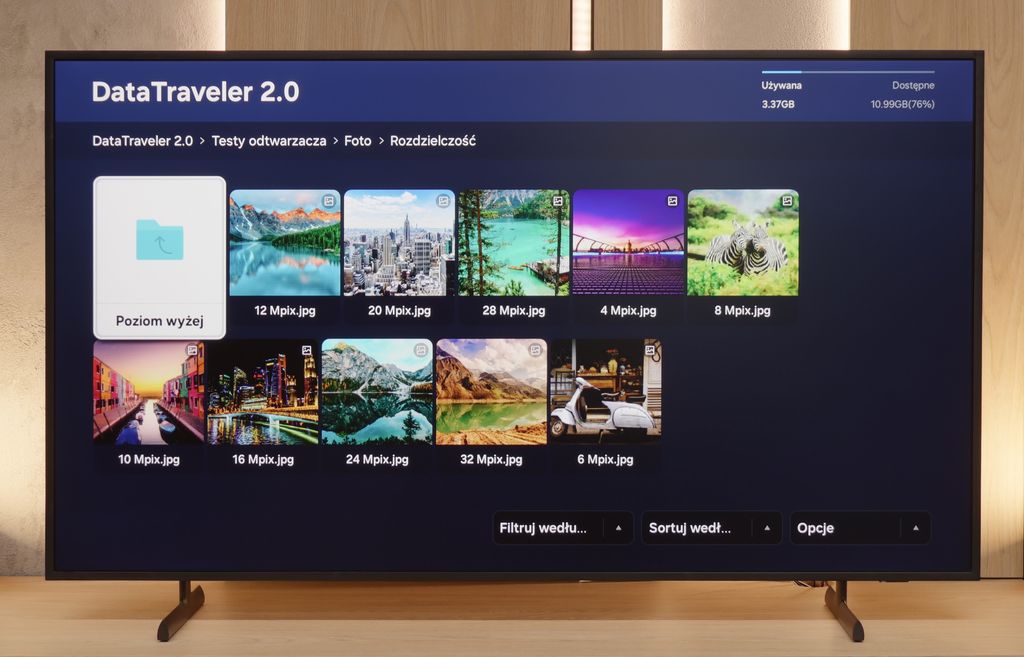
Stand: Height adjustment
Flat design: Yes
Accessories: Stand, Wall bracket, One Connect Box
Design is undoubtedly one of the greatest advantages of The Frame. Samsung has paid attention to details – the package includes a special wall mount that allows the TV to be perfectly flush with the wall, creating the impression of a hanging picture. Moreover, all cables connect to an external One Connect module, which connects to the TV via a single cable. This means you don't have to take the screen down from the wall to connect a new device.
The TV itself is quite slim, but it has been intentionally equipped with thicker bezels that resemble a classic picture frame. There is an option to purchase additional frames in various colors and styles, which can be quickly and easily exchanged. Unfortunately, the frames are not included in the package – you have to pay extra for them, although promotions often arise where you can receive them for free or for a symbolic amount with the purchase of the TV.
Buy in the best price
Select size:
SAMSUNG LS03F - Contrast and black detail
6/10
Local dimming function: No

Result
4,800:1

Result
4,750:1

Result
14,900:1

Result
4,500:1

Result
4,300:1
Visibility of details in the lights:
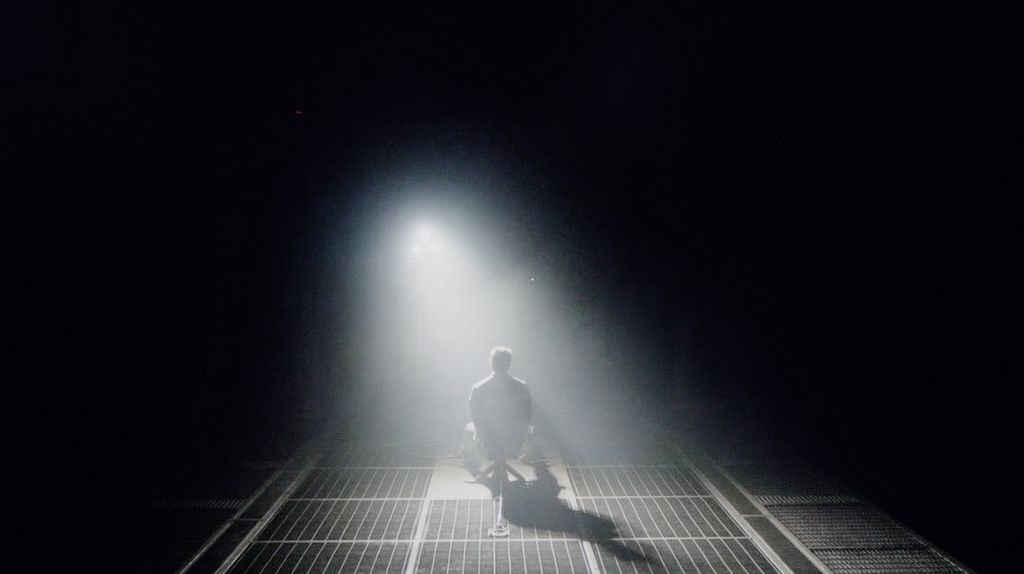
The year 2025 looks quite interesting when it comes to lifestyle TVs. Why? Because Samsung has prepared two versions of the iconic model The Frame – one regular and another with the "Pro" label. In this review, we take a look at the version without "Pro," which – as will soon become evident – is quite significant. The regular model LS03F does not feature any local dimming technology, unlike its more expensive sibling. This is important because it affects not only the overall picture quality but primarily how this TV handles black levels.
The VA panel used in The Frame 2025 has a high native contrast – and this obviously works to its advantage. In the tested movie scenes, details in the dark parts of the image were clearly visible; nothing blended together, and it didn’t create a uniform black/bright spot. For the average viewer, this will be more than sufficient. But of course, not everything is perfect. The lack of local dimming causes the black levels on this TV not to be perfectly deep – it resembles a dark navy more than pitch black. Additionally, in our tested unit, we noticed slight backlighting in the right part of the screen, but this may just be the "beauty of the specimen" rather than a rule. Theoretically, one could try to improve the perception of blacks by backlighting the screen – for example, with an LED strip – but in the case of The Frame, this is rather impossible because this TV is meant to sit flush against the wall like a painting. So to achieve better blacks visible to our eyes, we are forced to watch the LS03F with the lights on. Such is the charm of this technology.
Halo effect and black detail visibility:
SAMSUNG LS03F - HDR effect quality
6/10
Supported formats: HDR10, HDR10+, HLG Color gamut coverage: DCI P3: 91.5%, Bt.2020: 72.2%
Luminance measurements in HDR:

Result
642 nit

Result
589 nit

Result
574 nit

Result
584 nit

Result
631 nit
The Frame LS03F is a television that can surprise with its brightness. The maximum luminance reaches around 650 nits, which already looks solid on paper. But as we know, lab tests are one thing, and real movie scenes tell a completely different story. When watching HDR content in natural conditions, The Frame 2025 maintains very good results. In most film scenes, peak brightness remained at levels of 550–650 nits. This is enough to feel the difference between standard image quality and that of HDR – bright highlights, reflections on water, and moonlight appear clear and impressive.
It’s also worth noting that the LS03F is a QLED television, which translates to solid color saturation. The coverage of the DCI-P3 color space reaches about 92%, allowing for vibrant, intense colors in HDR content. It may not be at the level of top premium models, but for a lifestyle screen, the result truly deserves recognition.
Scene from the movie “Pan” (about 2800 nits)

Scene from the movie “Billy Lynn” (about 1100 nits)

Although the LS03F is not one of the TVs designed for extremely bright HDR scenes, its adaptive capabilities – that is, how it handles very demanding material – can be considered quite successful. Test segments from the films Pan and Billy Lynn, known for their unusual dynamics and high brightness, were reproduced surprisingly well.
Even though these scenes exceed the typical capabilities of equipment in this class, the LS03F did not lose details. Bright elements, such as the sun in Pan or the fireworks in Billy Lynn, did not merge into a single white blob. The image remained clear, and the transitions between brightness and the rest of the frame retained a discernible structure.
Some reservations can be made about the color reproduction – especially regarding skin tone. In some scenes, the palette appeared unnatural or was slightly skewed towards warmer tones. However, this is not a major complaint, but rather a detail noticeable in direct comparison.
It is somewhat unfortunate that the television was not equipped with properly functioning dynamic tone mapping. As is the case with many Samsung models, the option in the LS03F, when active, simply brightens the entire image, flattening contrast and robbing scenes of their intended depth. In our opinion, it is better to leave the tone mapping set to static – the effect is more balanced and closer to the intentions of the filmmakers.
HDR luminance chart:
HDR luminance
LS03F supports a wide range of HDR formats, including HDR10 and HDR10+, which has gained popularity in recent years. And that's a good thing – the dynamic metadata on which HDR10+ relies can convey the creators' intentions much better than the static settings known from classic HDR10. This is particularly evident in the test scene with horses on a snowy meadow.
As usual, one can have reservations about the lack of support for Dolby Vision. Samsung consistently omits this format in all its TVs, which can be a downside for users of streaming platforms that focus on Dolby. On the other hand, if the pace of HDR10+ development continues – which seems likely – the differences in content availability may eventually become less significant.
Static HDR10

Dynamic: HDR10+

Factory color reproduction
7.1/10
When it comes to image quality right out of the box, even in Filmmaker mode, which is supposed to be the closest to reference, there were issues. In both HD and 4K HDR content, we noticed noticeable deviations in white balance. The image was heavily skewed towards red and blue, giving the screen a characteristic rosy tint. This effect was most visible in bright scenes – for example, in shots with a lot of white, where neutral light should naturally dominate. In such moments, the screen clearly leaned towards pink tones, which can also be seen in the attached comparison photo. As for brightness characteristics – it wasn't as bad as one might expect given such color inaccuracies. Analysis of the gamma curve and EOTF showed a slight brightening of the image compared to the reference, but not enough to drastically affect the perception of the material.
Color reproduction after calibration
8/10
After calibration, the movie mode gained a completely new quality. The issue of pink tint, which had previously been clearly visible, especially in bright scenes, was effectively eliminated. Colors began to look much more natural, and the white balance no longer dominated the rest of the image. It was no longer the same exaggerated “box picture” – everything gained coherence and a cinematic character. Additionally, the tendency of the television to slightly brighten scenes, previously visible in the EOTF curve analysis, was partially corrected. Of course, this was within the limits of what the design allows without local dimming – it’s hard to speak of perfect brightness management here. Nevertheless, the final effect was definitely closer to what one would expect from a mode called Filmmaker.


SAMSUNG LS03F - Smoothness of tonal transitions
9/10
In terms of the fluidity of tonal transitions, the LS03F maintains a high level – just like last year’s models. The television had no issues during the testing of more challenging movie scenes, where visible transitions between color shades can easily occur. The color grading is very good here – both in the lighter and darker parts of the image. We did not observe the typical banding effect or other disturbances that could stand out while watching movies. If we had to nitpick, in the most demanding scenes – with subtle transitions and delicate gradients – small imperfections can be noticed. But only when one gets really close to the screen and begins to analyze the image from a distance not intended by the manufacturer.








Image scaling and smoothness of tonal transitions
6.7/10
Smooth transition function

Image without overscan on the SD signal

The LS03F is equipped with the NQ4 processor, which is responsible for improving image quality—especially in lower-quality materials. In practice, it works surprisingly well, particularly with older content and recordings with lower resolution. Activating the "noise reduction" feature yields noticeable effects. The television effectively smooths tonal transitions and removes digital noise that can appear in darker areas of the image. Compared to previous generations, there is a clear improvement—previously, this feature often smoothed everything too much, including details that it shouldn't have removed. In this year's model, the smoothing still occurs, but it is done in a much more acceptable manner. Textures of materials, skin, or fabric details are no longer so heavily muted as before—the image retains more naturalness. However, this does not change the fact that film grain is still removed by the television, which may not be to everyone's liking. On the other hand, it is no longer as aggressive an intervention as in previous models. It is also worth mentioning that the LS03F may struggle with very weak signals—such as recordings from VHS tapes or video in low resolution. In such cases, we noticed slight clipping of the image at the edges—so-called overscan. This can lead to situations where a small part of the image (e.g., subtitles at the bottom edge) gets cut off.
SAMSUNG LS03F - Blur and motion smoothness
6.9/10
Maximum refresh rate of the panel: 144Hz
Film motion smoothing option: Yes
Blur reduction option: Yes
BFI function 60Hz: Yes, 60Hz (image flickers)
BFI function 120Hz: No
Brightness drop with BFI: 43%
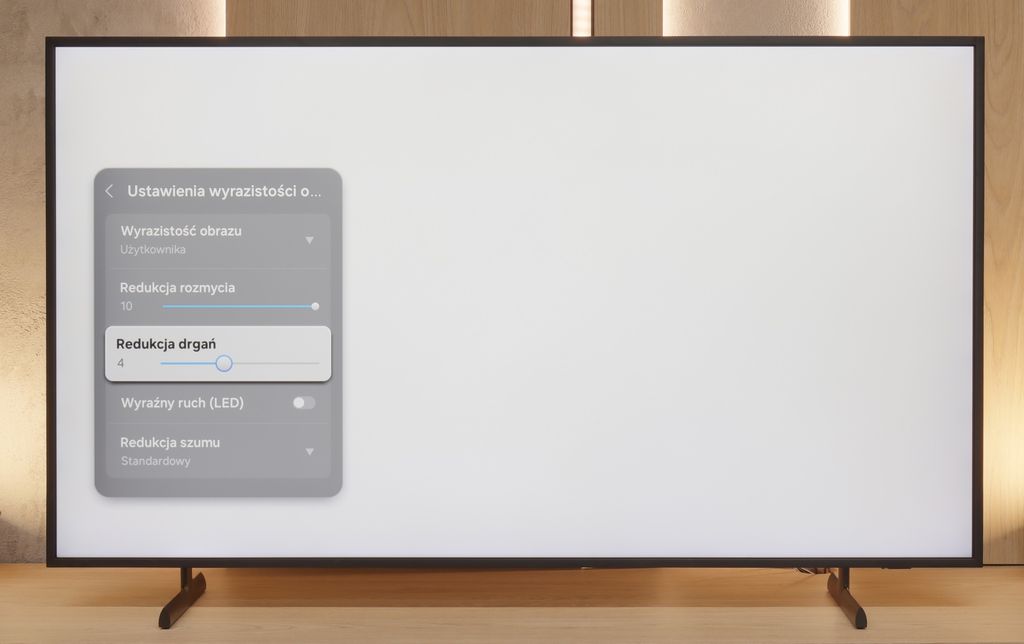
A novelty in The Frame for 2025 is the panel with a refresh rate of 144 Hz. Yes – in a television primarily associated with displaying artwork, you can now not only watch Van Gogh but also comfortably play on a console or follow dynamic sports action. This is a definite step towards greater versatility. In the case of Samsung films, as usual in models with a 120 Hz panel and above, it allows you to adjust motion smoothness according to your own preferences. You can set a more cinematic representation while maintaining frame rate or opt for full motion smoothing. The range of options is wide, allowing you to tailor the effect to your taste – whether the viewing experience is meant to resemble classic cinema or a presentation on a modern theater panel.
*this part of the test refers to the model LS03FAU in sizes 55 and 65 inches, which is equipped with a 144Hz panel; the 43 and 50-inch sizes have 60Hz panels, and therefore perform much worse in terms of motion smoothness.
Blur (native resolution, maximum refresh rate):



Blur (BFI function enabled):
Image flickers in this mode



The motion handling is actually quite good. In the UFO test, it’s hard to talk about the perfection that organic OLED panels can offer, but for an LCD television that will display static (images) or semi-static content 99% of the time, the effect was more than decent. Motion remains clear, contours do not overly blur, and single artifacts do not hinder everyday use – even with dynamic sports content or games.
It’s also worth mentioning a feature called “LED Motion,” which is classic BFI. It works with 60 Hz content and indeed makes the image look smoother. Unfortunately – as with most TVs – its usefulness leaves a lot to be desired. There is flicker, possible ghosting, and the screen loses almost half of its brightness. This can be considered more of a curiosity than a function for real use.
SAMSUNG LS03F - Console compatibility and gaming features
8.2/10
ALLM: Yes
VRR: Yes
VRR range: 48 - 144Hz
Dolby Vision Game Mode: No
Correct implementation of HGIG: No
1080p@120Hz: Yes
1440p@120Hz: Yes
4K@120Hz: Yes
Game bar: Yes
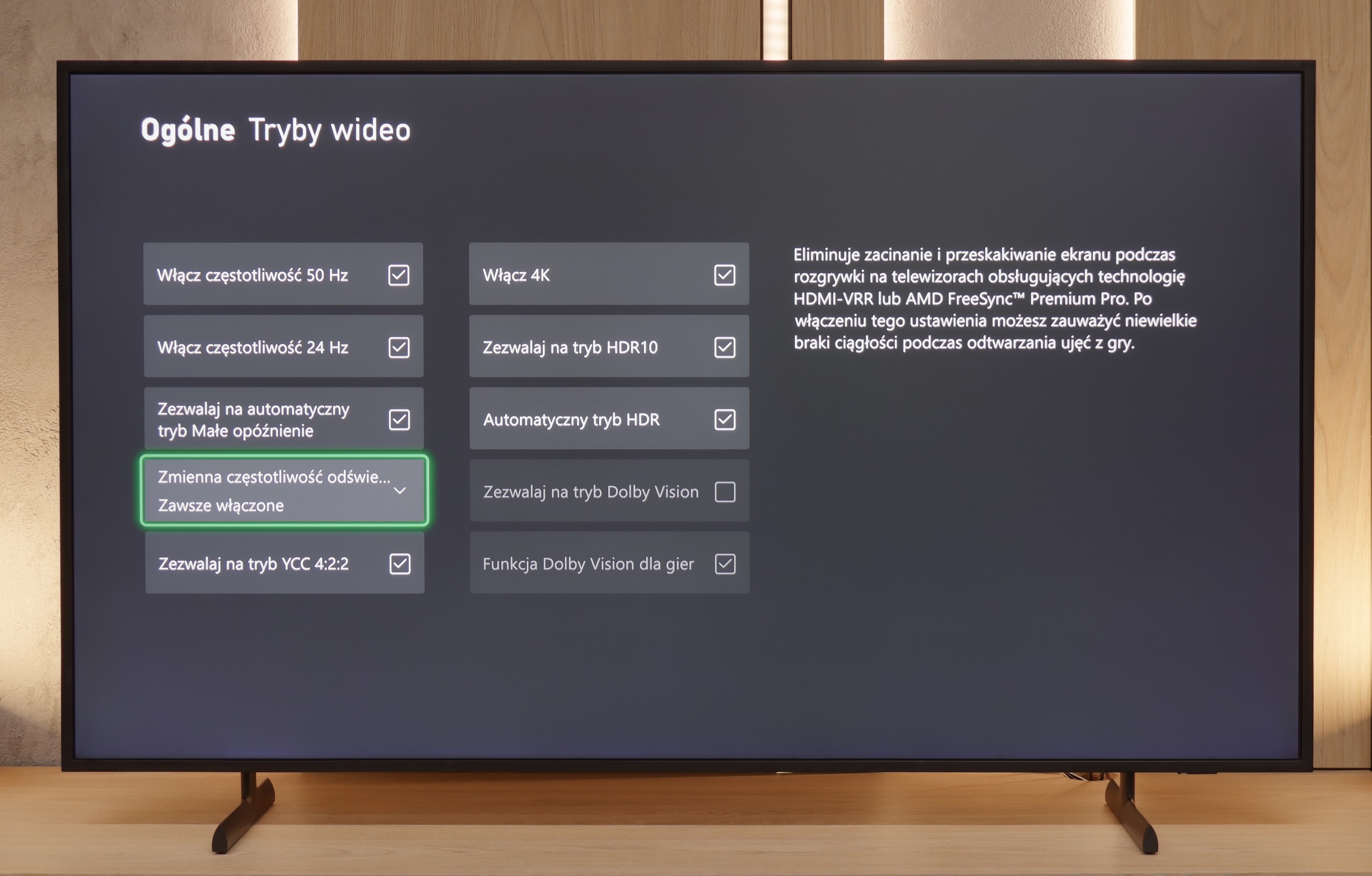
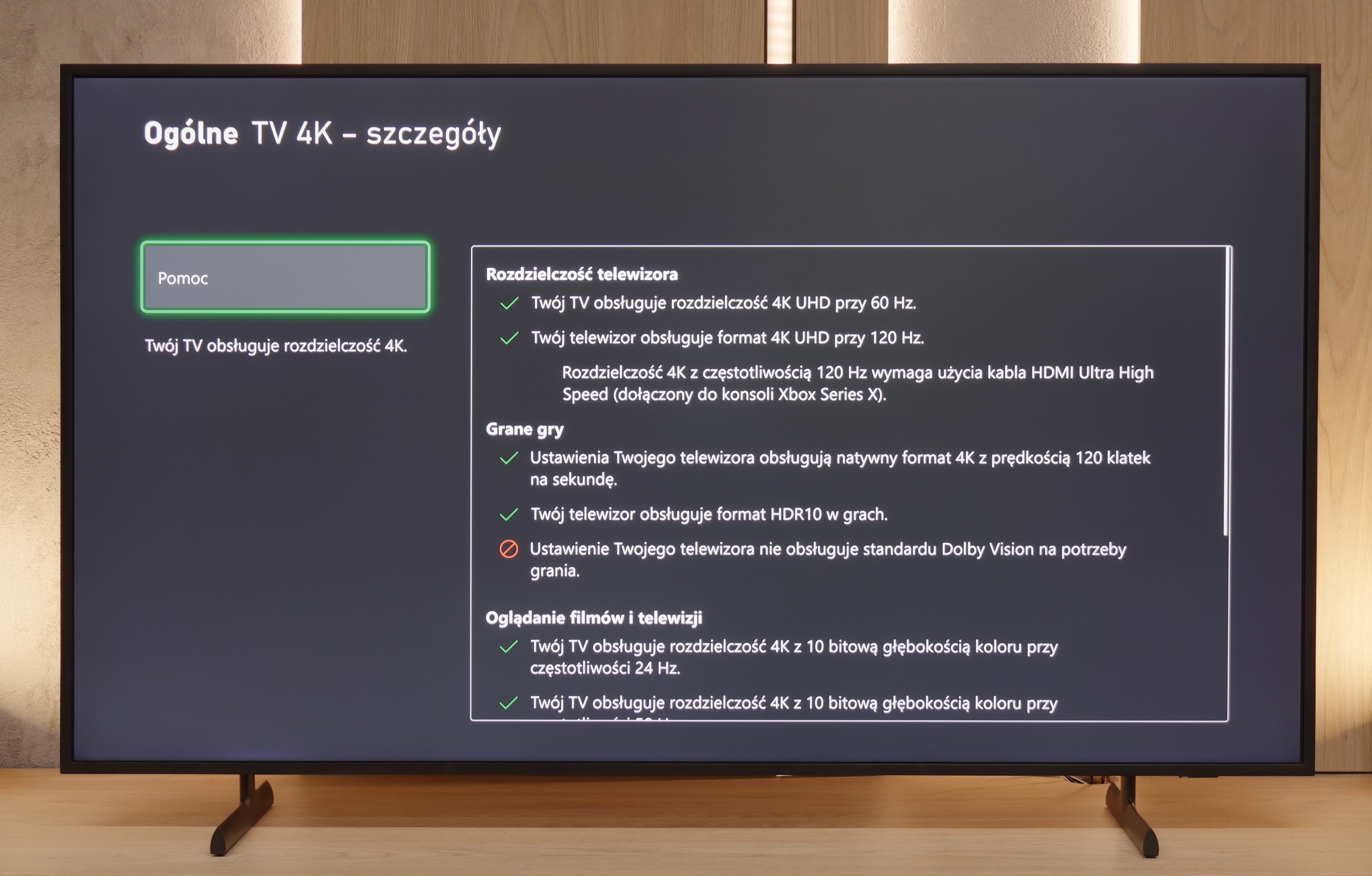
As we mentioned earlier – although The Frame likely displays images and works of art most of the time, Samsung has recognized that a Van Gogh enthusiast can just as easily be an avid gamer. And it must be admitted that The Frame 2025 has almost everything it needs to become a fully-fledged gaming television.
On board, we find support for ALLM (automatic game mode) and variable refresh rate (VRR) thanks to the implementation of one HDMI 2.1 port. The television handles lower resolutions at higher refresh rates without any issues and features an expanded Game Bar – already known from other Samsung models – which allows for quick previewing and changing of the most important gaming-related settings. For this, it earns additional points from us. The proprietary motion smoother Auto Motion Plus Game also deserves special mention, which – and it's worth emphasizing – works without increasing input lag. Samsung remains the only manufacturer that has managed to implement this feature in a practically noticeable way in terms of delays. The result? Much better fluidity in games, especially those that struggle to maintain stable 60 frames. This solution can realistically improve the gaming experience in more demanding titles – especially on consoles that don’t always manage full fluidity, especially in AAA games.
As for the downsides – the lack of Dolby Vision is already considered standard in Samsung televisions, so there's nothing to particularly complain about here. However, the problem is something entirely different. In the latest version of the Tizen system, the HGiG option has disappeared. Literally – it's not there. This is a significant setback when configuring a console for proper HDR content display in games. It’s hard to understand why such a decision was made, but one thing is certain – this should be fixed as soon as possible. We are talking about a brand that has set standards for gaming on televisions for years. If HGiG comes back – and we hope that it will – The Frame LS03F can confidently aspire to be a true gaming television. Not just as a decoration on the wall, but as equipment that really provides joy in gaming.
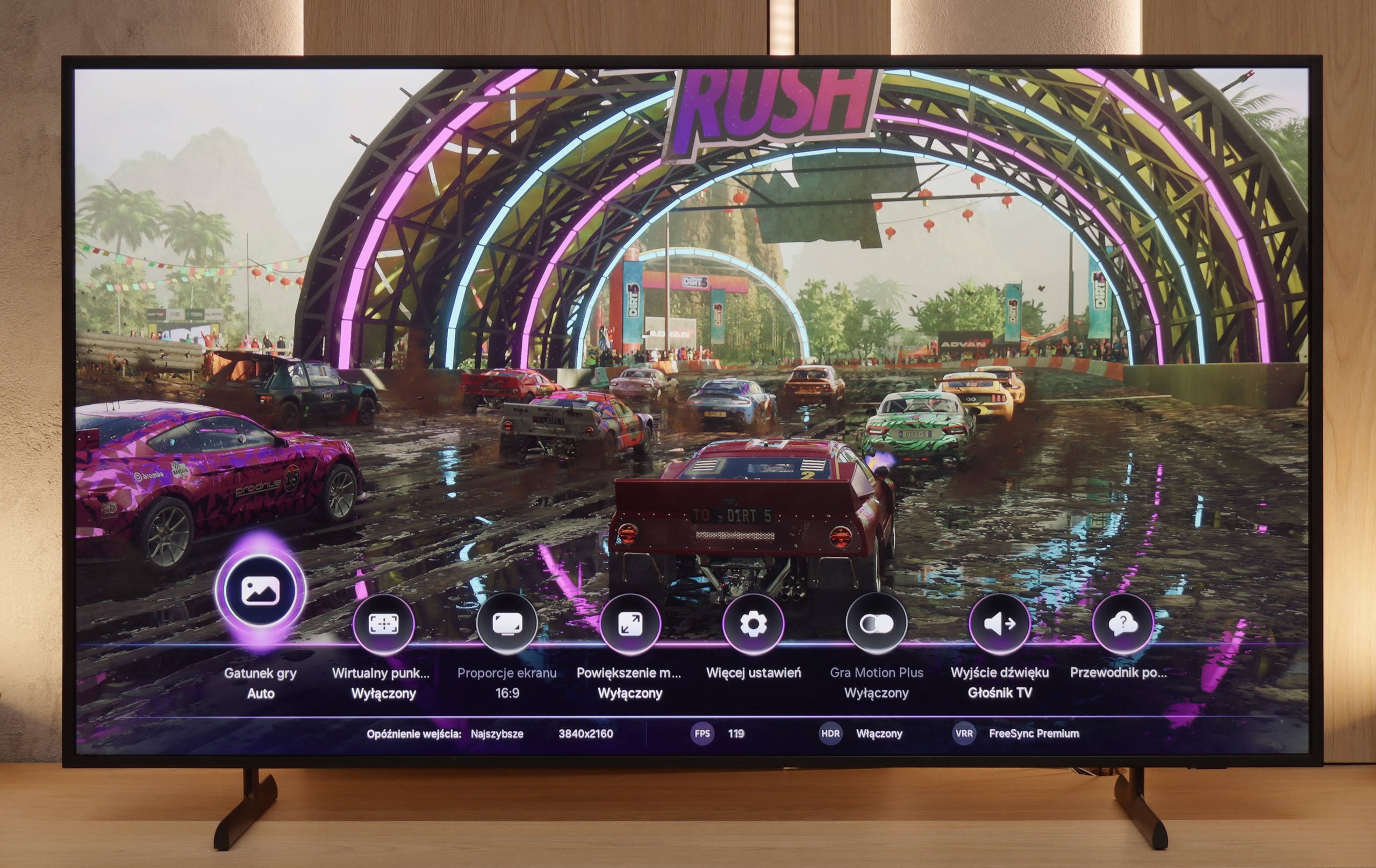
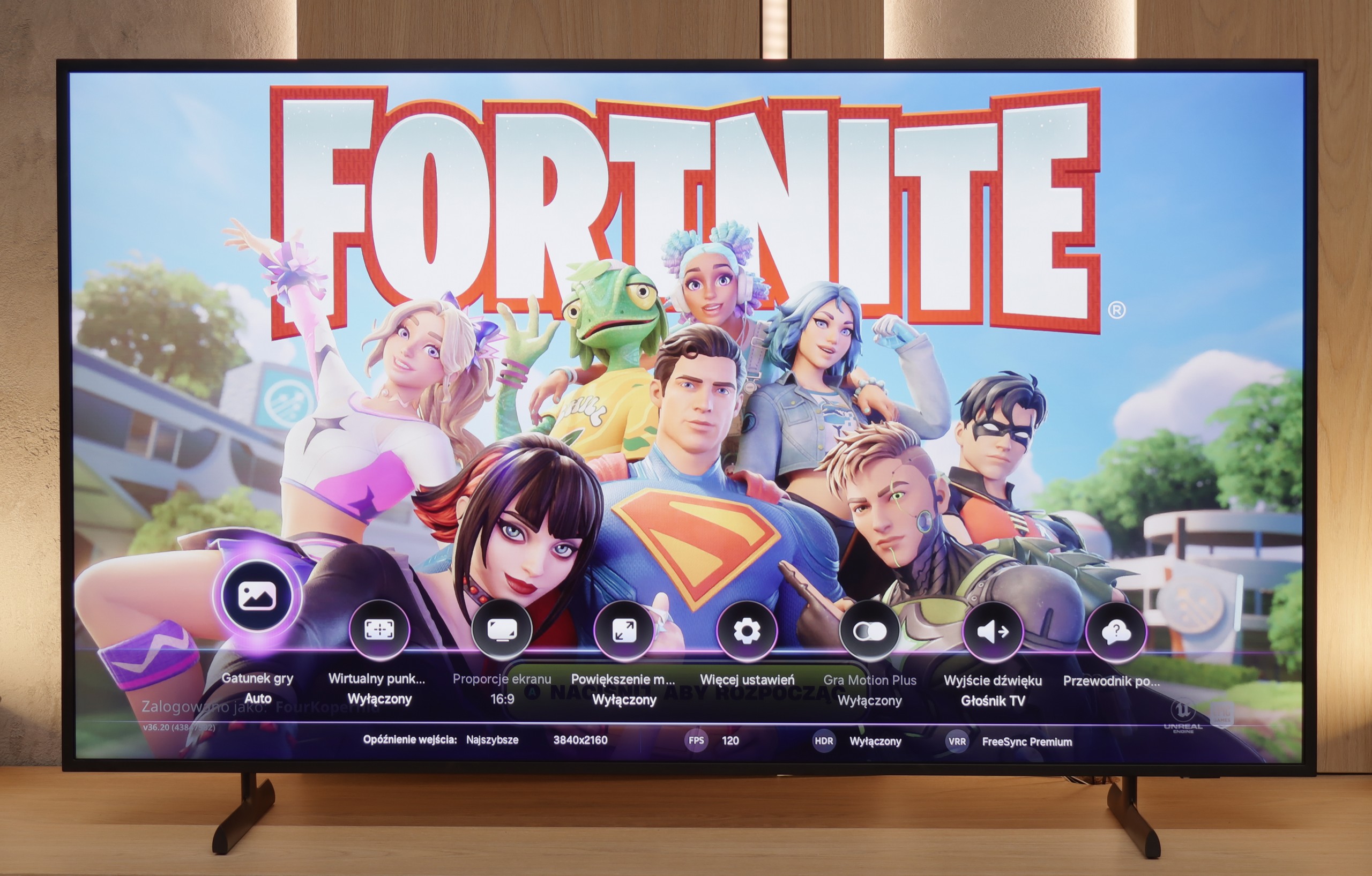

SAMSUNG LS03F - Input lag
10/10
In terms of input lag, Samsung maintains a high standard – and it's a very high one. The LS03F, like most of this year's models from this brand, achieves a score of 8 ms for 4K content, which is almost a reference value. This result allows you to play even the most dynamic titles without delays and with full responsiveness. Well done!
| SDR | HDR | Dolby Vision |
|---|---|---|
| 1080p60: 13 ms | 2160p60: 13 ms | |
| 1080p120: 8 ms | 2160p120: 8 ms | |
| 2160p60: 13 ms | ||
| 2160p120: 8 ms |

SAMSUNG LS03F - Compatibility with PC
8.2/10
Chroma 444 (maximum resolution and refresh rate): Yes
Font clarity: Good
Readability of dark text and shapes: Average
Input lag in PC mode (4K, maximum refresh rate): 8ms
Matrix subpixel arrangement: BGR
Max refresh rate: 144Hz
G-Sync: Yes
The collaboration of The Frame 2025 with a computer poses no major issues. Let's start with gaming, as this is where this model shows its strengths – support for a 144 Hz signal, low input lag, and compatibility with G-Sync technology (for NVIDIA cards) make it hard not to consider it a fully-fledged gaming monitor. It is one of the more interesting "PC gaming" TVs available on the market in this class.
When it comes to daily work, the situation looks just as good. The Frame easily handles chroma 4:4:4, which translates to good font readability and overall user comfort. We only noticed minor issues with dimming very thin lines and dark details on a bright background – this effect may occur particularly when working with small interface elements. However, in practice, with a 55-inch screen and standard office working distance, it will be difficult to notice this problem realistically. Nonetheless, it's worth keeping this in mind if the television is to serve as a monitor not only for entertainment but also for precise work with graphics or text.
SAMSUNG LS03F - Viewing angles
3.5/10
Brightness drop at an angle of 45 degrees: 70%
As one could expect from a VA panel, the viewing angles on The Frame 2025 are at best average. The image loses saturation and contrast when viewed off-angle. It’s a pity, because we are talking about a model that displays digital artworks while in standby mode—and it is precisely in such moments that wide viewing angles would make the most sense, enhancing the feeling of being in the presence of a real image, rather than just its screen imitation.
Perhaps in the future, manufacturers will decide to introduce special coatings or modified versions of VA panels that will improve this aspect—because in the case of lifestyle televisions, it would have real significance not only in terms of usability but also aesthetics.
SAMSUNG LS03F - TV efficiency during daytime
6.3/10


Matrix coating: Matte
Reflection suppression: Very Good
Black levels during daytime: Poor
One of the most characteristic features of The Frame is its matte display – and it must be admitted that Samsung has really refined this aspect. From our experience, this is one of the best solutions for reducing reflections, especially direct ones. If reflections on the screen can be irritating, it will be hard to find a better display in this budget than the matte panel used in Samsung TVs. Of course, this comes with a certain compromise. In very strong sunlight, colors may appear slightly washed out, and the image loses some depth. However, this is something we consciously accept when choosing a matte screen – something for something. In practice, the colors and contrast on Samsung's matte screen still perform better than on Chinese models like TCL NXT Vision or Hisense Canvas TV. If effectively reducing reflections and the desire to use the TV also as a 'digital picture' in bright rooms are priorities, it’s hard to find a better choice.
The Frame achieves about 600 nits of brightness, which, combined with the matte coating, allows the TV to handle well-lit daytime conditions without any issues. It may not reach the level of flagship models, but in everyday use – in a living room with plenty of light – it performs seamlessly.
Matrix brightness
Average luminance SDR
Samsung The Frame 2025 (LS03F): 596 cd/m2
SAMSUNG LS03F - TV features
7.2/10
System: Tizen
System performance: Good
- HDMI inputs: 3 x HDMI 2.0, 1 x HDMI 2.1 40Gbps
- Outputs: Toslink (Optical audio), eARC (HDMI), ARC (HDMI)
- Network Interfaces: Wi-Fi 2.4GHz, Wi-Fi 5GHz
- TV reception: DVB-T, DVB-T2, DVB-S, DVB-S2, DVB-C
Classic features:
Recording to USB (terrestrial TV): No
Recording programming: No
Picture in Picture (PiP): No
RF remote control (no need to aim at the screen): RF
Backlit remote control: No
Teletext: Yes
Audio only mode: Yes
Bluetooth headphones support: Yes
Simultaneous Bluetooth headphones & TV audio: Yes
Smart features:
AirPlay: Yes
Screen mirroring (Windows Miracast): Yes
Voice search: Yes
Voice search in native language: Yes
Ability to connect a keyboard and mouse: Yes






Classic TV Features
In terms of classic features, The Frame does not stand out in any way compared to the competition. There is no USB recording option or PiP (picture in picture) feature, which may be disappointing for some users. On the other hand, the TV allows for simultaneous use of speakers and headphones, which can be useful – especially for older users. The EPG, or electronic program guide, is quite readable, and despite the lack of traditional buttons on the remote, we managed to launch even the teletext. In everyday use, the basic functions work smoothly and without significant complaints.
Smart System – Tizen and Apps
The Frame 2025 runs on the Tizen operating system, which has been considered one of the most refined Smart TV solutions on the market for years. It is a system designed for devices that are more than just a television – and it was created with that spirit in mind. Tizen offers full integration with external devices – supporting both Apple AirPlay and Miracast. With the SmartThings app, it is possible to control not only the television but also other devices within the smart home. Since last year, Samsung has also been developing its own voice assistant with support for the Polish language, which significantly facilitates operation. However, the greatest strength of the Smart system in The Frame remains the Art Gallery app. Although access to it is paid (via subscription), it offers the best art scans on the market – we are talking about scans, not just ordinary photos. As a result, the effect of a digital artwork hanging on the wall looks much better than in any other lifestyle TV.
Sound connection options
HDMI audio:
Other audio outputs:
Toslink: Yes
Wireless audio:
Bluetooth: Yes
Obsługiwane formaty audio:
Dolby Digital Plus 7.1: Yes
Dolby True HD 7.1: No
Dolby Atmos in Dolby Digital Plus (JOC): Yes
Dolby Atmos in Dolby True HD: No
DTS:X in DTS-HD MA: No
DTS-HD Master Audio: No
Ułatwienia dla seniorów
Numeric keyboard on TV: No
Font size adjustment: Yes
Audio description: Yes
SAMSUNG LS03F - Apps
8.7/10























SAMSUNG LS03F - Playing files from USB
9.1/10

| Maximum photo resolution: | Supported photo formats: |
|---|---|
During testing, we did not notice any major problems with playing files from a USB memory. The TV handled both video materials and photos well. Of course, there are some exceptions – for example, lack of support for the HEIC format (used by Apple devices) – but it’s hard to consider this surprising. On the plus side, there is full support for high-resolution photos – the TV displays files with a high number of megapixels without any issues, which may be particularly important for those who want to treat The Frame as a digital frame as well. However, during testing, we noticed a limitation regarding subtitles – the TV only properly handled files in the .txt format. It's worth keeping this in mind and ensuring that the downloaded subtitles for movies are saved in this format, otherwise they may simply not display.
SAMSUNG LS03F - Sound
6/10
-
Maximum volume
Supported codecs
(TV speakers)
Dolby Digital Plus 7.1
Dolby True HD 7.1
Dolby Atmos in Dolby Digital Plus (JOC)
Dolby Atmos in Dolby True HD
DTS:X in DTS-HD MA
DTS-HD Master Audio
For such a slim TV, the sound is quite good. It's full, sufficient for everyday viewing, but without much excitement – typical for flat designs. There's not much bass, although at times it can be heard. The speakers in a 2.0.2 configuration have a total power of 40 W (in the 55+ inch version). Unfortunately, the TV does not support DTS format, so when watching films with that audio, external equipment, such as a home theater system, must be used. You can connect a soundbar, and thanks to the Q-Symphony feature, the TV plays along with it. Samsung also offers visually matching models to The Frame like S700D or S800D, but they are sold separately. (This shouldn't surprise anyone😉).
Acoustic Measurements
No acoustic data
SAMSUNG LS03F - Details about the matrix
Software version during testing: T-PTMFDEUC-0090-1110.7, E2500007, BT-S
Subpixel Structure:
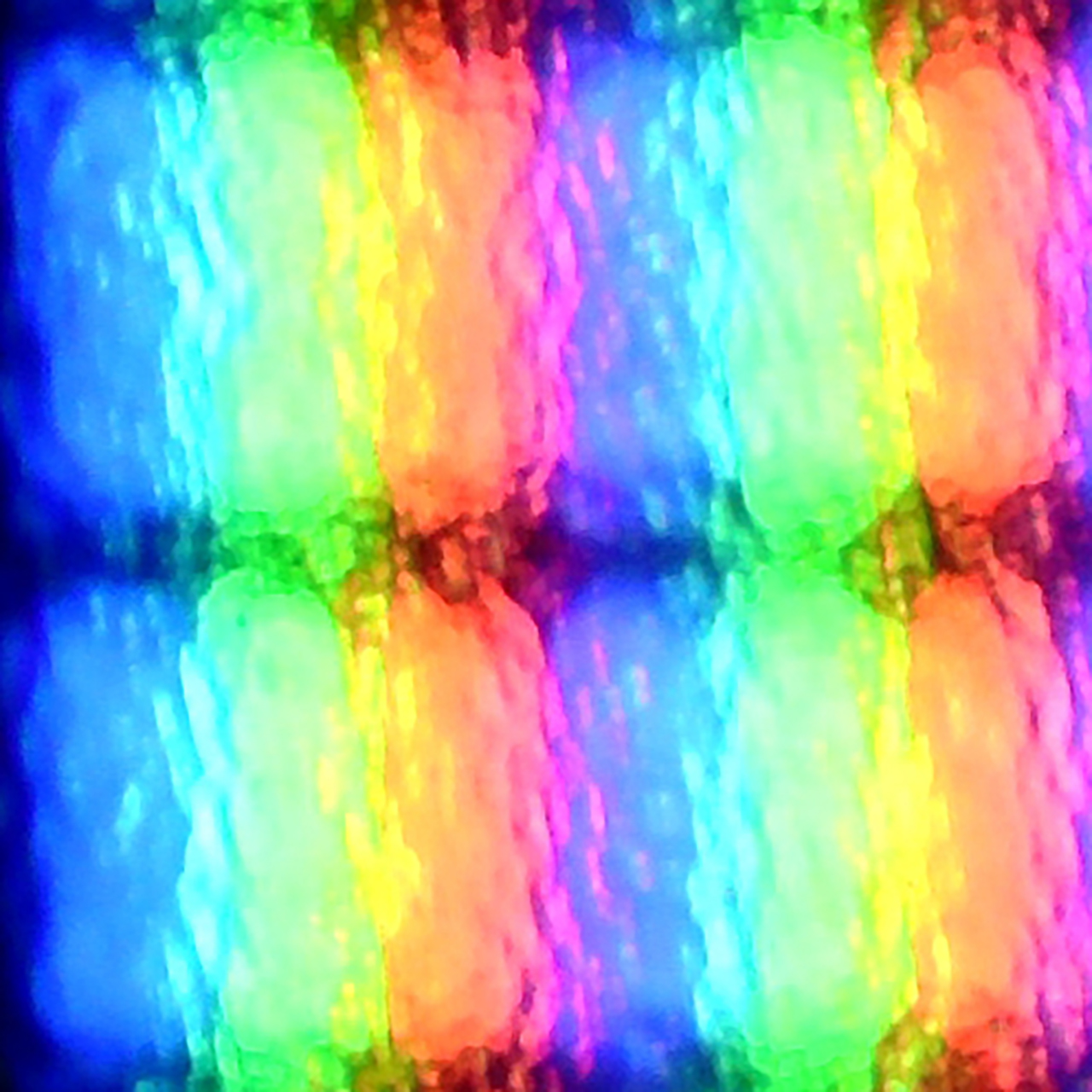
Panel uniformity and thermal imaging:
Backlight Type: QLED

Founder and originator of the "ChooseTV" portal

Journalist, reviewer, and columnist for the "ChooseTV" portal
See articles related to Samsung The Frame 2025 (LS03F):
Shopping Reviews
The best Samsung TVs 2024 / 2025! Which Samsung TV to choose... 4/30/2025



